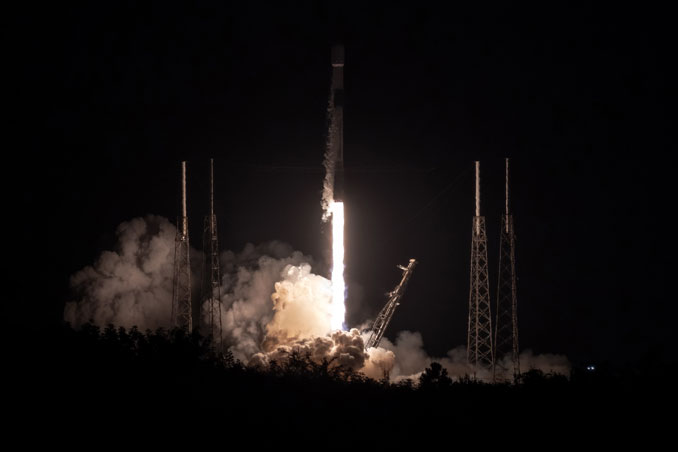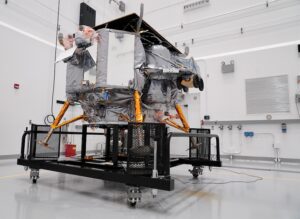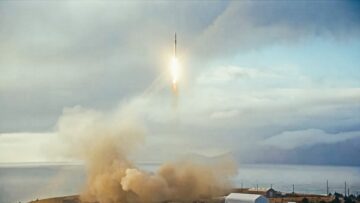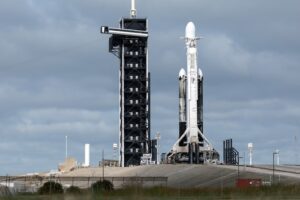
SpaceX launched a Falcon 9 rocket from Cape Canaveral early Friday morning carrying another 22 second-generation Starlink satellites into orbit.
Liftoff from pad 40 occurred at 1:17 a.m. EDT (0517 UTC), the last launch opportunity of the night after the Falcon 9 was put in place at the pad too late to make earlier launch attempts. The first stage booster, tailnumber B1069, was making its ninth flight. It previously launched the Cargo Dragon CRS-24, Eutelsat Hotbird 13F, OneWeb 1, and SES-18/SES-19 missions, plus four Starlink deployment flights. Its last flight was the Starlink 5-12 mission on 23 June 2023.
After lifting off from Space Launch Complex 40, the Falcon 9 soared south-east, targeting an orbit inclined at 43 degrees to the equator. After separating from the second stage about two and a half minutes into flight, the first stage booster continued downrange for a landing on the drone ship Just Read the Instructions, stationed in the Atlantic east of the Bahamas.
[embedded content]
The booster had previously flown the Crew-6, SES O3b mPOWER and the Starlink 4-4 missions. Its last launch was 37 days ago.
Two burns of the second stage were required to place the satellites into the required circular orbit. Separation of the 22 satellites was confirmed about one hour, five minutes after launch.
It will be the 11th launch of the so-called V2 mini satellites which are larger and have four times the bandwidth of the previous models. The full-sized V2 Starlink satellites are due to be launched by SpaceX’s fully-reusable Starship vehicle, but the delayed debut of Starship led SpaceX to create a condensed version of the satellites so they could be launched on Falcon 9.

In early May, SpaceX announced it had more than 1.5 million subscribers to Starlink. The company’s internet service is available in more than 60 countries.
- SEO Powered Content & PR Distribution. Get Amplified Today.
- PlatoData.Network Vertical Generative Ai. Empower Yourself. Access Here.
- PlatoAiStream. Web3 Intelligence. Knowledge Amplified. Access Here.
- PlatoESG. Automotive / EVs, Carbon, CleanTech, Energy, Environment, Solar, Waste Management. Access Here.
- PlatoHealth. Biotech and Clinical Trials Intelligence. Access Here.
- ChartPrime. Elevate your Trading Game with ChartPrime. Access Here.
- BlockOffsets. Modernizing Environmental Offset Ownership. Access Here.
- Source: https://spaceflightnow.com/2023/08/10/live-coverage-22-starlink-satellites-set-to-soar-from-cape-canaveral/
- :is
- 1
- 11
- 17
- 2023
- 22
- 23
- 40
- 60
- 9
- a
- About
- Adam
- After
- ago
- an
- and
- announced
- Another
- ARE
- At
- Attempts
- AUGUST
- available
- Bahamas
- Bandwidth
- BE
- booster
- burns
- but
- by
- Cargo
- carrying
- Company’s
- complex
- CONFIRMED
- content
- continued
- could
- countries
- create
- credit
- Days
- debut
- Delayed
- deployment
- Dragon
- drone
- due
- Earlier
- Early
- East
- embedded
- Facility
- falcon
- Falcon 9
- File
- First
- five
- flight
- Flights
- For
- Force
- four
- Friday
- from
- had
- Half
- Have
- hour
- http
- HTTPS
- in
- Inclined
- inside
- instructions
- Internet
- into
- IT
- ITS
- jpg
- june
- just
- landing
- larger
- Last
- Late
- launch
- launched
- Led
- lifting
- make
- Making
- max-width
- May..
- million
- minutes
- Mission
- missions
- models
- more
- morning
- night
- now
- occurred
- of
- off
- on
- ONE
- Opportunity
- Orbit
- pad
- photo
- Place
- plato
- Plato Data Intelligence
- PlatoData
- player
- plus
- previous
- previously
- processing
- put
- Read
- required
- rocket
- satellites
- Second
- separating
- service
- So
- soared
- Space
- Space Force
- SpaceX
- Stage
- starlink
- starship
- station
- subscribers
- targeting
- than
- The
- The Bahamas
- they
- times
- to
- too
- two
- UTC
- vehicle
- version
- Video
- was
- were
- which
- will
- youtube
- zephyrnet







